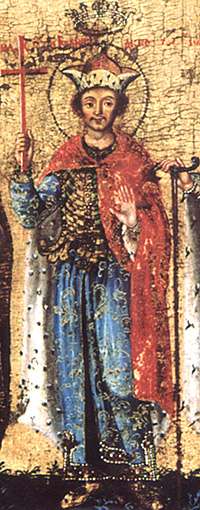Jovan Branković
Jovan Branković (pronounced [jɔ̌v̞an brǎːnkɔv̞itɕ] ; died 10 December 1502) was the titular Despot of Serbia from 1496 until his death in 1502. He held the title of despot given to him by Vladislas II of Hungary, and ruled a region known as Rascia, being equivalent of modern Vojvodina, under the Kingdom of Hungary. Despot Jovan was the last Serbian Despot of the Branković dynasty, which was regarded as legitimate successors of the "holy Nemanjić's", they continued the ktetorship to Hilandar and other sacred things to protect the nation and the religion (Serbian Orthodox Church).[1] He was proclaimed a Saint in 1505, under the name Saint Despot Jovan.
| Jovan Branković | |
|---|---|
 Detail of Andreja Raičević's icon (c. 1645), depicting Jovan as a saint | |
| Despot of Serbia | |
| Reign | 1496–1502 |
| Predecessor | Đorđe Branković |
| Successor | Jelena Jakšić |
| Died | 10 December 1502 |
| Burial | Krušedol monastery |
| Spouse | Jelena Jakšić |
| House | Branković |
| Father | Stefan Branković |
| Mother | Angelina |
| Religion | Serbian Orthodox Christian |
Background
The Ottoman Empire had conquered Serbia during the rule of Stefan Tomašević; Sultan Mehmed II had arrived at Smederevo, and by June 20, 1459, the Serbian capital was officially conquered. In 1463, they had conquered Bosnia as well.
In 1404, Sigismund of Hungary gave Stefan Lazarević the Syrmia region. His successor, Đurađ Branković, Jovan's grandfather, began ruling in 1427. Đurađ Branković was deemed by his contemporaries as the richest monarch, having a steady income from the gold and silver mines of Novo Brdo.
Life
Jovan was the son of Stefan Branković, despot of Serbia 1458–1459 and Saint Angelina.
He ruled jointly with his brother Đorđe from 1493, and when Đorđe took monastic vows (he becomes the Archbishop of Belgrade, Maxim), Jovan took the throne in 1496. He had different goals to those of his brother Đorđe, Jovan did not seek to create a heavenly empire, but sought to defeat the Turks and drive them out of his lands, and as such be entitled the ranks of his ancestors. He fought successfully with the Ottoman Empire, several operations in Bosnia, especially around Zvornik. Jovan planned to free the Serbs from Ottoman rule with the help of the Republic of Venice, but he was stopped with his death in 1502. After his death, the hope of restoring Serbia under the advancing of the Ottoman Empire became weaker.[2]
He married noblewoman Jelena Jakšić, with whom he had four daughters. After his death, his wife ruled as Despotissa and then she married Ivaniš Berislavić, who was given the title despot of Serbia in 1504 by the Hungarian King.
He is mentioned in the "Dell'Imperadori Constantinopolitani", or Massarelli manuscript, found in the papers of Angelo Massarelli (1510–1566).[3]
Sainthood
Saint Despot Jovan | |
|---|---|
| Saint | |
| Died | 10 December 1502 Krušedol monastery, present day Vojvodina, Serbia |
| Venerated in | Serbian Orthodox Church |
| Feast | December 2 |
His cult began in 1505. He was buried at the Krušedol monastery, and laid together with his family in coffins at the altar after the death of his brother, the Bishop Maxim (January 18, 1516), later given sainthood on December 2.[1] The Turks, however, burned the holy relics in 1716 after the loss at Battle of Petrovaradin and only the left arm of Angelina and some minor body parts of other members were spared, proclaimed holy relics of the Serbian Orthodox Church.[2]
Family
He married Serbian noblewoman Jelena Jakšić, who is mentioned as “Helena, Serbiæ despotissa” in a charted dated to 1502. They had 4 children, all of whom were daughters:
- Marija, married Ferdinand Frangepan of the House of Frankopan
- Jelena, married Peter IV Rareş, Prince of Moldavia
- Hanna, married Fiodor Sanguszko, Marshal of Volhynia[4]
- Maria Magdalena, married Iwan Wiśniowiecki, a noble from Volhynia[4]
Taking into account the dates of marriage and of bearing children of the last two daughters, researchers assume that they were daughters of the second marriage of Jelena Jaksić with Ivaniš Berislavić [5]
Some genealogies also indicate that another daughter, Milica Despina, married Neagoe Basarab, Prince of Wallachia (1512–21).[6] Some believe Milica was too old to be his daughter, but she was born cca. 1486-1488 [7]. Milica Despina might have been an illegitimate daughter of his or other close relative or even the daughter of Jovan's brother Đorđe with whom she went to Wallachia in 1503.
| Ancestors of Jovan Branković | |||||||||||||||||||||||||||||||||||||||||||||||||||||||||||||||||||||||||||||||||||||||||||||||||||||||||||||||||||||||||||||||||||||||||||||||||||||||||||||||||||||||||||||||||||||||||||||||||||||||||||||||||||||||||||||||||||||||||||||||||||||||||||||||||||||||||||||||||||||||||||||||||||||||||||||||||||||||||||||||||||||||||||||||||||||||||||||||||||||||||||||||||||||||||||||||||||||||||||||||||||||||||||||||||||||||||||||||||||||||||||||||||||||||||||||||||||||||||||||||||||||||||||||||||||||||||||||||||||||||||||||||||||||||||||||
|---|---|---|---|---|---|---|---|---|---|---|---|---|---|---|---|---|---|---|---|---|---|---|---|---|---|---|---|---|---|---|---|---|---|---|---|---|---|---|---|---|---|---|---|---|---|---|---|---|---|---|---|---|---|---|---|---|---|---|---|---|---|---|---|---|---|---|---|---|---|---|---|---|---|---|---|---|---|---|---|---|---|---|---|---|---|---|---|---|---|---|---|---|---|---|---|---|---|---|---|---|---|---|---|---|---|---|---|---|---|---|---|---|---|---|---|---|---|---|---|---|---|---|---|---|---|---|---|---|---|---|---|---|---|---|---|---|---|---|---|---|---|---|---|---|---|---|---|---|---|---|---|---|---|---|---|---|---|---|---|---|---|---|---|---|---|---|---|---|---|---|---|---|---|---|---|---|---|---|---|---|---|---|---|---|---|---|---|---|---|---|---|---|---|---|---|---|---|---|---|---|---|---|---|---|---|---|---|---|---|---|---|---|---|---|---|---|---|---|---|---|---|---|---|---|---|---|---|---|---|---|---|---|---|---|---|---|---|---|---|---|---|---|---|---|---|---|---|---|---|---|---|---|---|---|---|---|---|---|---|---|---|---|---|---|---|---|---|---|---|---|---|---|---|---|---|---|---|---|---|---|---|---|---|---|---|---|---|---|---|---|---|---|---|---|---|---|---|---|---|---|---|---|---|---|---|---|---|---|---|---|---|---|---|---|---|---|---|---|---|---|---|---|---|---|---|---|---|---|---|---|---|---|---|---|---|---|---|---|---|---|---|---|---|---|---|---|---|---|---|---|---|---|---|---|---|---|---|---|---|---|---|---|---|---|---|---|---|---|---|---|---|---|---|---|---|---|---|---|---|---|---|---|---|---|---|---|---|---|---|---|---|---|---|---|---|---|---|---|---|---|---|---|---|---|---|---|---|---|---|---|---|---|---|---|---|---|---|---|---|---|---|---|---|---|---|---|---|---|---|---|---|---|---|---|---|---|---|---|---|---|---|---|---|---|---|---|---|---|---|---|---|---|---|---|---|---|---|---|---|---|---|---|---|---|---|---|---|---|---|---|---|---|---|---|---|---|---|---|---|---|---|---|---|---|---|---|---|---|---|---|---|---|---|---|---|---|---|---|---|---|---|---|---|---|---|---|---|---|---|---|---|---|---|---|---|---|---|---|---|---|---|---|---|---|---|---|---|---|---|---|---|---|---|---|---|---|---|---|---|---|---|
| |||||||||||||||||||||||||||||||||||||||||||||||||||||||||||||||||||||||||||||||||||||||||||||||||||||||||||||||||||||||||||||||||||||||||||||||||||||||||||||||||||||||||||||||||||||||||||||||||||||||||||||||||||||||||||||||||||||||||||||||||||||||||||||||||||||||||||||||||||||||||||||||||||||||||||||||||||||||||||||||||||||||||||||||||||||||||||||||||||||||||||||||||||||||||||||||||||||||||||||||||||||||||||||||||||||||||||||||||||||||||||||||||||||||||||||||||||||||||||||||||||||||||||||||||||||||||||||||||||||||||||||||||||||||||||||
| Wikimedia Commons has media related to Jovan Branković. |
References
- Hilandar Research Library; Matejic, P.; Thomas, H. (1992). Catalog: Manuscripts on Microform of the Hilandar Research Library (The Ohio State University). Resource Center for Medieval Slavic Studies (The Ohio State University). ISBN 9780893572266. Retrieved 2015-03-22.
- university, A.I.C. Medieval and Early Modern for Central and Eastern Europe. Al I Cuza University Press. p. 110. Retrieved 2015-03-22.
- Tony Hoskins. "Anglocentric medieval genealogy". newsgroups.derkeiler.com. Archived from the original on 2011-07-16. Retrieved 2015-03-22.
- Wasilewski, Tadeusz (1963). "Przyczynki źródłowe do stosunków Polski ze Słowiańszczyzną południową w wiekach XIII-XVI". Studia Źródłoznawcze: Commentationes (in Polish). Warsaw: Institute of History of the Polish Academy of Sciences. 8: 121–125. ISSN 0081-7147.
- "Lilia Zabolotnaia - Câteva precizări despre Dinastia Brankovic". scribd.com. Retrieved 2015-03-22.
- The Byzantine tradition in church embroidery p. 89
- George Marcu, Rodica Ilinca, Enciclopedia personalităţilor feminine din România, Editura Meronia, Bucureşti, 2012,
Sources
- "Dell'Imperadori Constantinopolitani"
- Mitrović, K. 2008, "Povelja despotice Jelene Jakšić manastiru Hilandaru", Stari srpski arhiv, no. 7, pp. 195–203.
- Tubić, D. 2006, "The Branković family from Srem in historiography", Spomenica Istorijskog arhiva Srem, no. 5, pp. 232–242.
- Ćirković, Sima (2004). The Serbs. Malden: Blackwell Publishing.CS1 maint: ref=harv (link)
| Regnal titles | ||
|---|---|---|
| Preceded by Đorđe Branković |
Serbian Despot (titular) 1496–1502 |
Succeeded by Ivaniš Berislavić |